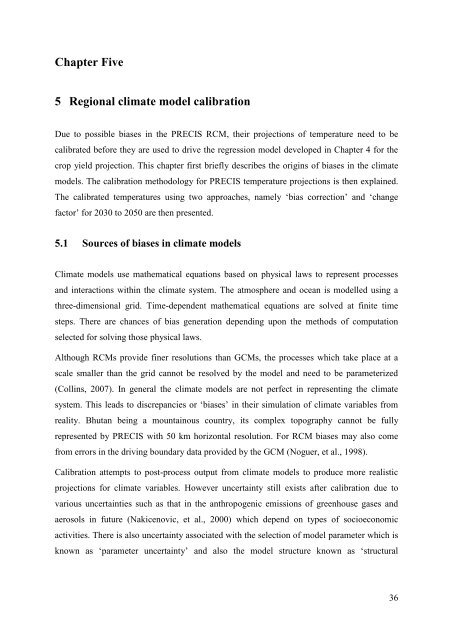UNIVERSITY OF READING - E-Library - WMO
UNIVERSITY OF READING - E-Library - WMO
UNIVERSITY OF READING - E-Library - WMO
Create successful ePaper yourself
Turn your PDF publications into a flip-book with our unique Google optimized e-Paper software.
Chapter Five5 Regional climate model calibrationDue to possible biases in the PRECIS RCM, their projections of temperature need to becalibrated before they are used to drive the regression model developed in Chapter 4 for thecrop yield projection. This chapter first briefly describes the origins of biases in the climatemodels. The calibration methodology for PRECIS temperature projections is then explained.The calibrated temperatures using two approaches, namely ‘bias correction’ and ‘changefactor’ for 2030 to 2050 are then presented.5.1 Sources of biases in climate modelsClimate models use mathematical equations based on physical laws to represent processesand interactions within the climate system. The atmosphere and ocean is modelled using athree-dimensional grid. Time-dependent mathematical equations are solved at finite timesteps. There are chances of bias generation depending upon the methods of computationselected for solving those physical laws.Although RCMs provide finer resolutions than GCMs, the processes which take place at ascale smaller than the grid cannot be resolved by the model and need to be parameterized(Collins, 2007). In general the climate models are not perfect in representing the climatesystem. This leads to discrepancies or ‘biases’ in their simulation of climate variables fromreality. Bhutan being a mountainous country, its complex topography cannot be fullyrepresented by PRECIS with 50 km horizontal resolution. For RCM biases may also comefrom errors in the driving boundary data provided by the GCM (Noguer, et al., 1998).Calibration attempts to post-process output from climate models to produce more realisticprojections for climate variables. However uncertainty still exists after calibration due tovarious uncertainties such as that in the anthropogenic emissions of greenhouse gases andaerosols in future (Nakicenovic, et al., 2000) which depend on types of socioeconomicactivities. There is also uncertainty associated with the selection of model parameter which isknown as ‘parameter uncertainty’ and also the model structure known as ‘structural36
















